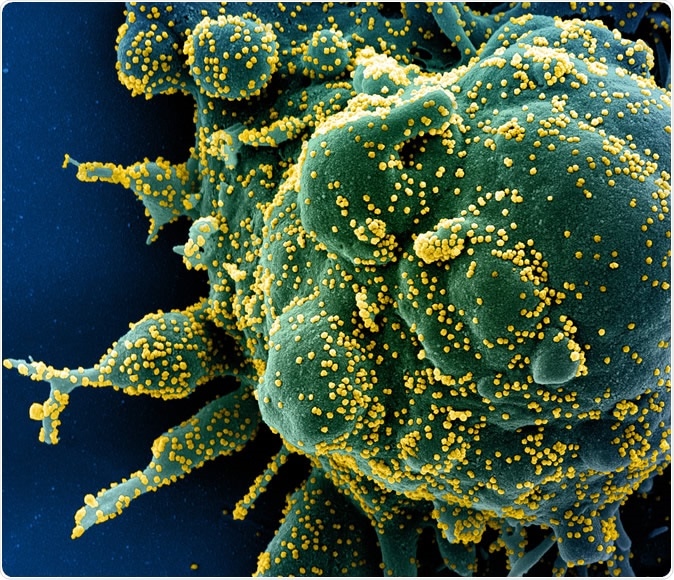The global novel coronavirus pandemic has taken its toll on the world, with more than 3.5 million people infected and at least 247,000 deaths. The novel coronavirus, officially known as the severe acute respiratory syndrome coronavirus 2 (SARS-CoV-2), is a virulent pathogen that can cause severe respiratory illness. Besides knowing the source of the virus, a team of researchers believes it to be crucial to understand how the virus has changed over time, especially in terms of virulence and aggressiveness.
Understanding the varying aggressiveness of SARS-CoV-2 may provide valuable data to trace its spread across populations. In the study, published on the preprint server BioRxiv*, the researchers traced amino acid variants that possess high frequency in Europe, particularly in Italy, one of the hardest-hit countries. The team found that these variants were absent in the first outbreak that occurred in Wuhan City, Hubei Province, in China, where the coronavirus disease (COVID-19) was first reported.

Novel Coronavirus SARS-CoV-2 Colorized scanning electron micrograph of an apoptotic cell (green) heavily infected with SARS-COV-2 virus particles (yellow), isolated from a patient sample. Image captured at the NIAID Integrated Research Facility (IRF) in Fort Detrick, Maryland. Credit: NIAID

 *Important notice: bioRxiv publishes preliminary scientific reports that are not peer-reviewed and, therefore, should not be regarded as conclusive, guide clinical practice/health-related behavior, or treated as established information.
*Important notice: bioRxiv publishes preliminary scientific reports that are not peer-reviewed and, therefore, should not be regarded as conclusive, guide clinical practice/health-related behavior, or treated as established information.
Rising new variants
Knowing the emergence of continuous new variants, specifically in genes coding for structural proteins, may aid in the virus evading the immune response. The researchers conducted an extensive study of the SARS-CoV-2 genomes isolated from patients in Italy throughout the pandemic in the country.
The first European nation that felt the full wrath of SARS-CoV-2 was Italy. The first local transmission case was reported on Feb. 20, in a young man in the northern region of the country, Lombardy. However, over the next 24 hours, another 36 cases of pneumonia-like illness were then reported. Since then, the country has a staggering 210,717 confirmed cases and more than 28,000 deaths. The country has one of the highest case tolls in Europe and worldwide.
The SARS-CoV-2 strain in Italy was seen to be different from the original one in China. To have a better understanding of the COVID-19 spread in the country, the team identified six non-synonymous mutations that differentiate the SARS-CoV-2 strain in Italy, from those in China. To do this, the team used the GISAID database and traced the relative frequency in the global scenario and different countries.
To arrive at their findings, the researchers extracted coding sequences from complete and partial genomes. They translated nucleotide sequences, and those with a high fraction of gaps were removed. Further, they manually edited sequences not well aligned, leading in a different number of sequences per alignment.
Then, the sequences from the multi-alignments were utilized to build amino acid frequency profiles using the R-package. For each protein encoded in the SARS-CoV-2, two profiles were obtained - one for Italian strains and one for the whole set of sequences.
Six positions in coding sequences
The team studied the time profiles and performed phylogenetic analysis. The results of the study showed that there are six positions in three proteins, where amino acid frequencies changed radically. The coding sequences had different patterns of amino acids when comparing Italian sequences with those found across the globe.
“Using this approach, we were able to follow the evolution of the virus over time among continents, showing that the different clades evolved in different moments and that their frequencies vary among continents,” the researchers wrote in the paper.
The team also found that one particular variant, the D614G on the spike protein, has been characterized by an increase in frequency since the end of January in many countries.
“Since then, it has overcome the original haplotype in most countries, suggesting it may indeed provide some advantage to the virus. However, to understand these issues, experimental data is required; for instance, in the form of Tn-insertion mutagenesis, as performed on other viruses in the past,” the team concluded.
The team revealed that this variant, which appeared in Germany on Jan. 28, has overcome the wild-type variant that arrived from China, suggesting various strains spreading across the globe. As the pandemic grows bigger, new information about the virus emerges, which helps track its behavior and activity. This way, scientists may predict scenarios of viral activity, whether the pandemic will subside shortly, or a vaccine is needed immediately to halt its spread.

 *Important notice: bioRxiv publishes preliminary scientific reports that are not peer-reviewed and, therefore, should not be regarded as conclusive, guide clinical practice/health-related behavior, or treated as established information.
*Important notice: bioRxiv publishes preliminary scientific reports that are not peer-reviewed and, therefore, should not be regarded as conclusive, guide clinical practice/health-related behavior, or treated as established information.
Source:
Journal reference: